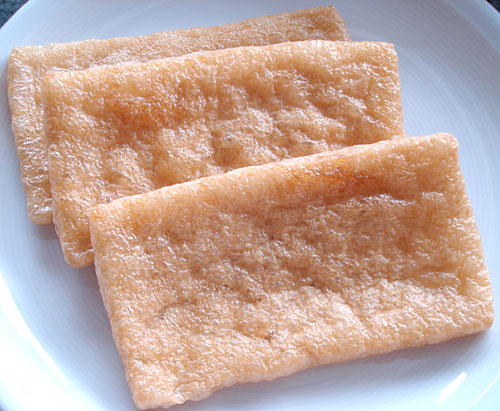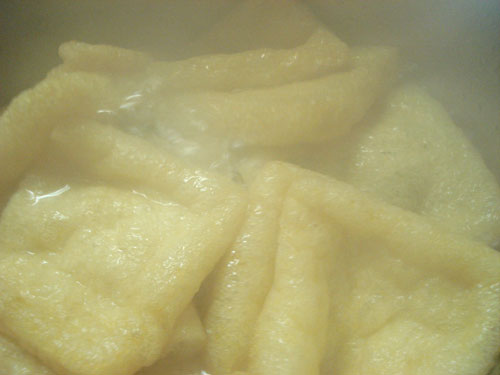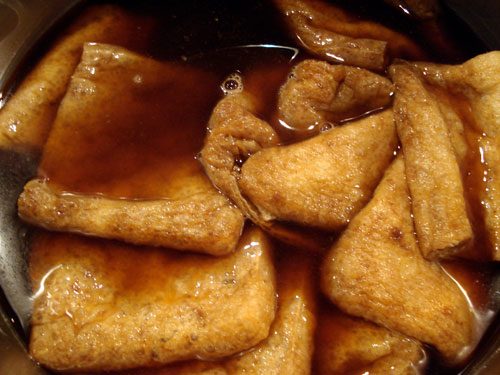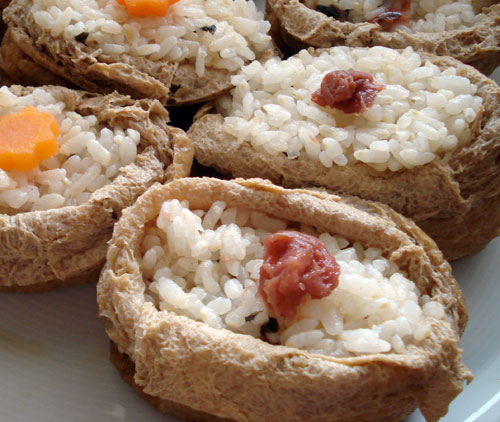Inarizushi (sushi in a bean bag) Redux: Cooking your own inarizushi skins

Four years ago I posted a very basic recipe for inarizushi, homely sushi that is stuffed into a fried tofu skin or aburaage. It's been one of the most popular articles here on Just Hungry ever since. That only gave instructions for stuffing pre-made (canned or vacuum packed) skins, so I thought I'd update it with instructions for making your own inarizushi skins from scratch. These instructions will be particularly useful to vegetarians and vegans, since most if not all premade skins are cooked in a fish-based traditional dashi stock. And, for all of you who have had problems making Eggs in Treasure Bags with those small, thin canned skins: You'll find that making the eggs from your own, sturdy skins is so much easier.
Preparing aburaage (fried tofu skins)
Aburaage (油揚げ) are made from plain tofu that's been sliced and then deep fried. When the slices are deep fried, they turn crinkly and form an air pocket inside. You can find aburaage in the refrigerated or freezer section of a Japanese grocery store. They are made in the same way as Chinese 'tofu puffs' or 'bean curd puffs', except they are large and flat instead of small and puffy.
This is how plain aburaage look.

They usually come packed 2 to 3 to a bag. I always keep aburaage in the freezer until I need them.
In Japan, aburaage are mostly used in stewed dishes, soups, and so on. Before it's cooked, you must blanch and de-oil it. This process is called aburanuki (油抜き) or yudoushi (湯通し); any Japanese cook knows how and when to do this, but it's one of those details that can get forgotten in translation so to speak. Anyway, it's very easy to do. Just put the whole aburaage in boiling water to cover for a couple of minutes.

Then drain the boiling water off. This gets rid of some of the surface oil. Let the aburaage cool down before handling further. You can wipe off even more surface oil by patting the aburaage down with paper towels. (Untreated aburaage is about 80-100 calories each, depending on the size; the de-oiling treatment gets rid of 15-20 calories worth of oil.)
At this point, you can use the aburaage as-is, cut into strips and put into miso soup for example, or just cut into half and simmered for a bit in udon noodle soup for kitsune udon. But do remember: When simmering aburaage, always de-oil it. It makes all the difference.
Recipe: Inarizushi skins
Once you have de-oiled your aburaage, making inarizushi skins from them is easy. I like to cut them in half first so that they are ready to stuff once they're cooked. I'm finding that the aburaage I can buy these days have nice big air pockets inside, so I don't have to do anything for them to naturally form bags. But if you find yourself with skinny aburaage where the sides 'stick' inside, you can loosen them up by rolling a chopstick over the surface before de-oiling. Then after de-oiling, you can gently pry the sides apart to form the bag.
Once you have your cut-in-half aburaage 'bags', it's time to cook them. This amount of poaching liquid is enough for 12 skins, or 6 (2 packs) of aburaage cut in half.
- About 1 1/3 cups (350ml) vegan dashi stock, traditional dashi stock, or plain water with 1 tsp. of dashi granules, OR just plain water
- 3 to 4 Tbs. sugar (depending on how sweet you want them to be), or an equivalent amount of alternative sweetener
- 2 Tbs. sake
- 2 Tbs. mirin
- 3 to 4 Tbs. dark soy sauce (depending on how salty you want them to be)
Combine all the ingredients in a pan and bring to a boil. Lower the heat to a simmer, and put in your de-oiled and cut in half aburaage skins. Simmer for about 15 minutes, until the liquid has evaporated down to about half the original amount. Turn off the heat and let the skins cool down in the liquid.

You can store them in the cooking liquid, well covered, in the refrigerator for 2-3 days. I haven't really tried freezing them, but you could try it out.
When you're ready to use the skins, just squeeze them out lightly so they aren't dripping. These skins are bigger (not to mention sturdier and easier to handle) than the canned kind, so you'll need more sushi rice per inarizushi, about 1/3 to 1/2 cup. Here is my basic sushi rice recipe; optionally add a teaspoon extra of sugar to the sushi vinegar mix. You can also try the lower calorie mix with hijiki seaweed, or mix in some toasted sesame seeds, shelled edamame, salmon flakes or furikake - whatever strikes your fancy.
You can present the inarizushi with the open end tucked under and down, as I described in the original inarizushi article. Note that the homemade inaruzushi skins are much lighter in color than the sometimes rather virulently reddish-brown canned kind. They are subtler in flavor too - you can really taste the tofu skin itself.

You can also present the inarizushi with the open end up (optionally fold down the edges for neatness). This is especially nice if you have colorful mixed rice as a filling. Here I've used some chopped up umeboshi in the rice, as well as as decoration. The umeboshi gives a subtle pink tint and pleasant sourness to the rice. (I used brown rice to make the sushi rice, which is why it's beige-ish.)

Another inarizushi stuffing technique, not shown here, is to turn the skins completely inside out, and then stuff as normal. This gives the inarizushi a sort of lacy look, which gives a nice contrast if you line when up with regular outside-in brown inarizushi on a plate or in a bento box.
For people who live outside of Japan, the only drawback to making your own inarizushi skins (besides the slight bother of actually cooking them) is that fresh or frozen aburaage can be rather expensive, compared to the long-shelf-life canned skins. (In Japan aburaage is a great budget protein!) Still, the flavor and texture are so much better, so if you can get a hold of aburaage, I hope you give it a try!
If you enjoyed this article, please consider becoming my patron via Patreon. ^_^

 Welcome to Just Hungry, where we serve authentic Japanese recipes and more! I'm
Welcome to Just Hungry, where we serve authentic Japanese recipes and more! I'm 













Comments
Kevin
25 March, 2009 - 17:02
Permalink
Re: Inarizushi (sushi in a bean bag) Redux: Cooking your ...
I remember I once cooked a small batch of aburaage for kitsune udon. Was it good or what!
Balifly
25 March, 2009 - 20:43
Permalink
Re: Inarizushi (sushi in a bean bag) Redux: Cooking your ...
That was timely, I just bought a can of the skin last weekend. I will prepare them for sushi and save some for udone later.
steph
25 March, 2009 - 21:02
Permalink
Re: Inarizushi (sushi in a bean bag) Redux: Cooking your ...
Thanks for the blanch and de-oiling tip - that's super useful. Great blog!
bronwyncarlisle
26 March, 2009 - 02:52
Permalink
Re: Inarizushi (sushi in a bean bag) Redux: Cooking your ...
So if you were going to start with tofu and deep fry it yourself, how thick would the slices be, and what sort of tofu?
maki
26 March, 2009 - 05:59
Permalink
Re: Inarizushi (sushi in a bean bag) Redux: Cooking your ...
You can try slicing firm tofu lengthwise, a bit less than 1 cm thick, then deep frying them in oil until a light golden brown. However, I've never been able to produce aburaage that has a nice pocket inside this way. Reading up on the subject in Japanese books and such, they all say that aburaage is made by a 'special process' but that process is not explained! On the other hand, homemade atsuage (where you just deep fry a block of tofu until golden brown) is delicious.
nofuhuli
27 April, 2009 - 00:46
Permalink
Re: Inarizushi (sushi in a bean bag) Redux: Cooking your ...
I think I can help a little regarding the "special process" used in making aburaage and why it may be challenging to create it on your own. The soymilk used to make tofu and aburaage differ in thickness; that is, how much beans are ground up to make the milk. Soymilk for tofu will be anywhere from 2.5 to 3 times as thick compared to that used for aburaage.
Lupe
4 March, 2012 - 15:55
Permalink
Re: Inarizushi (sushi in a bean bag) Redux: Cooking your ...
Searching for details on making atsuage, I found
these instructions for aburaage:
Tofu Recipe: Aburaage
HTH,
Lupe
Aleria
26 March, 2009 - 05:11
Permalink
Re: Inarizushi (sushi in a bean bag) Redux: Cooking your ...
Where could you buy aburaage outside of Japan? I live in Canada, would you have to go to an asian grocery store?
maki
26 March, 2009 - 06:01
Permalink
Re: Inarizushi (sushi in a bean bag) Redux: Cooking your ...
You will probably have to buy them at a Japanese (not general Asian or Chinese-oriented) grocery store. A Korean grocery store may carry them too. You can try looking up the Japanese grocery store list for your area.
Elin
26 March, 2009 - 05:32
Permalink
Re: Inarizushi (sushi in a bean bag) Redux: Cooking your ...
I love to make my own sushi and thanks for sharing how to make our very own inarizushi skins.You have a great blog and I am so happy I found your blog by chance :)
Tolovana
26 March, 2009 - 07:26
Permalink
Re: Inarizushi (sushi in a bean bag) Redux: Cooking your ...
I think the trick is to twice fry them - first cooking them, then puffing them. Like Pommes Souffles are done.
http://en.wikipedia.org/wiki/Aburaage
bronwyncarlisle
1 April, 2009 - 12:03
Permalink
Re: Inarizushi (sushi in a bean bag) Redux: Cooking your ...
There has to be more to it than that, I tried it at the weekend and got non-puffy deep-fried tofu slices. I think maybe the tofu needs to be MADE skinny, as when you fry sliced stuff the oil goes through the little bubbles. I think if it were made thin there would be a sort of skin on the exterior which would allow the insides to puff.
ruthie
13 June, 2011 - 19:00
Permalink
Re: Inarizushi (sushi in a bean bag) Redux: Cooking your ...
That sounds reasonable.
When making flatbreads that are supposed to have pockets, like pitas, you cook them on both sides, then crank up the heat. Slap them back on the really hot pan or griddle, and they puff.
It works because the original cooking seals the outside with a sort of "crust" so the steam can't escape. When you hit them again with the high heat, the steam has nowhere to go, and the pressure blows open the pocket.
So, if you fried the tofu slices once to seal the outsides, then hit them with the hot oil again, perhaps just oil in a saute pan would be enough, that high heat will force the pocket to form. Do you think it translates?
I'll have to try this now that I'm thinking about it. ;)
Kai
28 March, 2009 - 08:02
Permalink
Re: Inarizushi (sushi in a bean bag) Redux: Cooking your ...
when you serve them are they still damp from the soaking liquid? or are they supposed to be dry?
i tried drying them with a kitchen towel before stuffing them with rice but they're still damp--and i don't know if they're supposed to be that way or i should dry them off completely (which seems hard to do without tearing them)...
maki
28 March, 2009 - 11:02
Permalink
Re: Inarizushi (sushi in a bean bag) Redux: Cooking your ...
They should still be moist. I just squeeze them out gently with my hands so that they aren't dripping. The excess liquid penetrates the rice and makes it really delicious!
Kai
29 March, 2009 - 17:28
Permalink
Re: Inarizushi (sushi in a bean bag) Redux: Cooking your ...
haha, i was making them right then! i was worried that they had to be dry because the pictures i see in my japanese cookbooks look shiny but i can't tell if their moist or not.
thanks maki! ^_^
kattebelletje
1 April, 2009 - 11:02
Permalink
Re: Inarizushi (sushi in a bean bag) Redux: Cooking your ...
Thanks for posting maki! I just bought these bags last week from the Chinese supermarket, the lady said "to put sushi in" and I didn't quite understand what she meant, but I thought: "I'll google it later". Now I stumble by chance on the recipe I've been looking for (and I forgot the bags in the fridge somewhere)... Great, I'm going to try today!
Marissa
1 April, 2009 - 18:20
Permalink
Re: Inarizushi (sushi in a bean bag) Redux: Cooking your ...
oh very cool I want to try these soon
MissB
22 April, 2009 - 08:46
Permalink
Re: Inarizushi (sushi in a bean bag) Redux: Cooking your ...
Well I know what im going to be trying this weekened.
Im a huge fan of inarizushi to the extenet that if I walk past a shop selling it I can help but to buy some.
I have made it myself in the past using shop bought skins, but im keen to try mkaing it all myself from scratch
lucifuge
30 May, 2009 - 01:36
Permalink
Re: Inarizushi (sushi in a bean bag) Redux: Cooking your ...
WOW! Thanks! I tried making these for my sushi birthday party and they were a hit! I'd make them before without de-oiling them or making the marinade and they were good, but these were excellent. I used frozen skins. The lady at the Korean store tried to talk me out of making my own by telling me they had a package that came with the sauce. When I told her I was going to make my own, she seemed bewildered ;-) Thanks again SO MUCH for creating a delicious vegan version. It was much healthier than what I couldn've bought.
lucifuge
30 May, 2009 - 01:36
Permalink
Re: Inarizushi (sushi in a bean bag) Redux: Cooking your ...
WOW! Thanks! I tried making these for my sushi birthday party and they were a hit! I'd make them before without de-oiling them or making the marinade and they were good, but these were excellent. I used frozen skins. The lady at the Korean store tried to talk me out of making my own by telling me they had a package that came with the sauce. When I told her I was going to make my own, she seemed bewildered ;-) Thanks again SO MUCH for creating a delicious vegan version. It was much healthier than what I could've bought.
SushiTail
16 August, 2009 - 08:30
Permalink
Re: Inarizushi (sushi in a bean bag) Redux: Cooking your ...
I've never thought of using umeboshi in Inari. What a great idea! Thanks for sharing the recipe.
anon.
21 October, 2009 - 19:32
Permalink
Re: Inarizushi (sushi in a bean bag) Redux: Cooking your ...
a friends mum cooked these for us in the summer, i forgot to ask what they were called at the time but i've just stumbled upon this recipe after looking through your just bento site..
anyway these are the most delicious things, i felt so cute eating them as well :]
i hope there's somewhere in london i can get the ingredients you use because i would love to cook my own food, even if its just for the occasional treat. this site is bookmarked already, your amazing!
anon. Sumiko
13 August, 2010 - 21:46
Permalink
Re: Inarizushi (sushi in a bean bag) Redux: Cooking your ...
I tried to make aburage from slicing tofu(bean curd) but each time, I end up having hard aburage and not fluffy aburage we see in Japanese grocery stores.
I live in city of Philadelphia and we don't have Asian foods store where I can buy Japanese aburage.
There is Mituwa in NJ but it is too far for me to drive.
Only thing I can try is when next time I make trip to Asian grocery store, ask store manager to carry Japanese aburage.
Yes, inari zushi is so tasty and my one of favorite food.
anon.
3 September, 2010 - 01:07
Permalink
Re: Inarizushi (sushi in a bean bag) Redux: Cooking your ...
This recipe is great! I just finished making some, and they turned out wonderful! It was also my first time attempting sushi rice, and by following your recipe it came out very nice. :D
I only ripped one skin, sadly, but my boyfriend ate that one. He told me that because I made it and it was different from the others that made it even more delicious. :3
Also, I had a hard time finding even the canned aburaage for a while, then by chance found some at a Korean market. A whole pack of 16 freshly made ones, even! I was so excited!
Your website is fantastic, and I definitely am going to make a bunch of other recipes you have. (Your trick for making onigiri was awesome!)
edna lewis
9 October, 2010 - 21:31
Permalink
Re: Inarizushi (sushi in a bean bag) Redux: Cooking your ...
Any idea of calorie count/bag? With or without prepared rice? I tossed the can before I had a chance to note the nutrition information.
NealK
16 December, 2010 - 13:55
Permalink
Re: Inarizushi (sushi in a bean bag) Redux: Cooking your ...
I have some frozen inari Pouches, are there any specific tips/requirements when defrosting them ?
maki
16 December, 2010 - 14:46
Permalink
Re: Inarizushi (sushi in a bean bag) Redux: Cooking your ...
Defrost them in the liquid to keep them from drying out. Ideally defrost them overnight in the refrigerator, though you can do it in the microwave if you're careful.
some spammer
23 February, 2011 - 13:48
Permalink
Re: Inarizushi (sushi in a bean bag) Redux: Cooking your ...
This spam comment from someone trying to spam a site selling furniture 'beanbags' was so funny I left it in, stripped of the spammy links. -maki.
I have a few of these in my house. One of them is in my room, and two others are in my living room. They are extremely comfortable and come in a variety of colors. The actual frame comes in espresso or natural, and the cushions come in green, purple, red, orange, etc.
EricaVee
9 April, 2011 - 02:44
Permalink
Re: Inarizushi (sushi in a bean bag) Redux: Cooking your ...
These are just SO amazing. I haven't made any recipe from this site that hasn't completely blown my mind. Thank you so much for posting such clear instructions! I'm eating them right now and they are making me so happy.
amandaonmaui
14 August, 2011 - 07:10
Permalink
Re: Inarizushi (sushi in a bean bag) Redux: Cooking your ...
These turned out fantastically! I actually found locally produced aburage that don't contain wheat. I am gluten free, so that's why it took me so long to make these. I'd had cone sushi before at the local gas stations (they're sold with other cheap maki at the check out stand) and I was missing them a lot.
I'm delighted to have them again. Mahalo!
P.S. Here we put grated carrots in them.
AmandaonMaui
17 May, 2012 - 23:14
Permalink
Re: Inarizushi (sushi in a bean bag) Redux: Cooking your ...
Well, unfortunately those tofu skins ended up making me ill. They must not have been as safe as I thought. I finally ran across this post again, and I'm finally remembering to post that they weren't my friend. I only had to eat them once to know. I still haven't sourced a gluten free version.
Ruthan
3 July, 2012 - 21:45
Permalink
Re: Inarizushi (sushi in a bean bag) Redux: Cooking your ...
I found some of what appear to be little squares of atsuage -- they are flat with pockets, so not bean curd puffs, but came in a long plastic tray like fancy cookies. (I think I saw a picture of them on this site somewhere, but no recollection of what they were called)
Anyway, this sounds way more tasty than eating one plain, like I just did! :P I'm looking for a way to make flat brown things for the bento & co challenge, so will be trying this!
Emma
27 September, 2012 - 23:35
Permalink
Re: Inarizushi (sushi in a bean bag) Redux: Cooking your ...
i have brought these frozen, once thawed do i need to de-oil and cook them?
Anbu
9 March, 2013 - 03:09
Permalink
Re: Inarizushi (sushi in a bean bag) Redux: Cooking your ...
can I use canned inarizushi bags? or they have to be dry?
Sea
23 April, 2013 - 05:57
Permalink
Re: Inarizushi (sushi in a bean bag) Redux: Cooking your ...
For the gluten free readers... All seasoned aburaage in a can etc. contains wheat soy sauce. However, the plain aburaage just contains some kind of oil, tofu preservatives and tofu. I make inari zushi regularly using a recipe like this one but use wheat free soy sauce/tamari. Delicious!